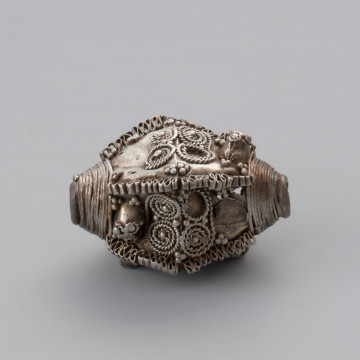
Temporal lanyard
951 — 1100
National Museum in Szczecin
Part of the collection: Middle Ages
The silver-coated temple ring was discovered in 1979 during excavations on an early-medieval cemetery in Cedynia, in a grave of a child. Temple rings, which were popular head decorations among West Pomeranian Slavic women, were attached to textile or leather bands, sometimes stiffened with bark, or to headscarves. They were worn in groups, from smallest to largest, on the temple, which is where their name comes from. They were made of wires or pieces of metal formed around a core, and they were hanged or sewn to other pieces using their small eyelets. Temple rings were usually made of non-ferrous metal alloys, with gold being the rarest material. Temple rings of various kinds have been discovered both within settlements and cemeteries, mainly in women’s graves. They are rare in the graves of children and men, where they were placed as gifts. The earliest ornaments of this kind are characterised by small diameters and wire-based construction. In the course of time, larger diameter rings began to emerge, as well as rings made of thin plates, sometimes richly ornamented. The so-called hollow temple rings, beautifully decorated with floral and animal motifs, are characteristic of West Pomerania.
Ewa Górkiewicz-Bucka
Author / creator
Dimensions
cały obiekt: height: 2.5 cm, width: 2.3 cm
Object type
tempel ring, jewellery, adornment
Technique
peening, rolling
Material
bronze
Origin / acquisition method
field research
Creation time / dating
Creation / finding place
Owner
Muzeum Narodowe w Szczecinie
Identification number
Location / status

951 — 1100
National Museum in Szczecin

951 — 1000
National Museum in Szczecin

966 — 1100
National Museum in Szczecin
DISCOVER this TOPIC
Museum of King Jan III's Palace at Wilanów
DISCOVER this PATH
Educational path